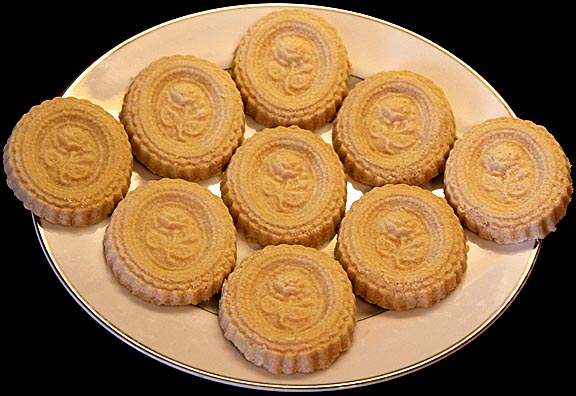

Wayne Schmidt's Scottish Shortbread Page: Detailed instructions with pictures showing how to make the best tasting Scottish shortbread
Please click here to jump down to a review of the best tasting shortbread cookie I've found.

Although it's
one of the simplest of all cookies to make, nothing can compare to
traditional
Scottish Shortbread in elegance or flavor.
History:
Scottish shortbread has been around at least since the early 1200s, where it evolved from a coarse, twice baked medieval biscuit rolled in sugar into something close to the delicious pastry we enjoy today. Developed first in Scotland, original recipes were based on the 1-2-3 formula of one part by volume of sugar, two parts butter and three parts oat flour. By the 1600s these treats had become refined by the replacement of oat flour with wheat flour and increasing the percentage of flour so that they could be imprinted with decorative shapes. Popularized by Mary, Queen of Scots, they spread across the world. Expensive to make at the time, they were reserved for special occasions.
Scottish shortbread comes in three traditional shapes: dinner plate sized rounds that are cut into wedges, individual serving sized rounds and rectangular fingers.
Scottish shortbread is the grandfather of all butter cookies, from which it differs in that it has no leavening agent such as baking powder. It's also different from shortcake, which also uses leavening and can incorporate solid fats other than butter.
Theories abound regarding how it got to be called "shortbread." The most popular is that the "short" was a word used to describe crisp, crumbly foods. Another explanation is that it refers to the process of shortening, where fat enrobes the gluten proteins in flour preventing them from forming long, chewy strings as they do in bread. Still another comes from the use of shortening rather than butter.
How To Make Scottish Shortbread:
While I was able to find dozens of Scottish Shortbread recipes, I could not find a reference that explained how different recipes compared. In particular, what effect changing the type and amount of ingredients had on finished cookies. Without this information it's impossible for the determined shortbread baker to develop a recipe that satisfies his or her particular preferences. Hence this webpage. It provides the type of detailed information needed to understand the consequences of changing the ratio of ingredients, type of ingredients and baking time. After reading this short page you'll be a master of Scottish shortbread, able to create your own unique recipe. This information is presented as a series of experiments so you can see how each factor affects the resulting cookie.
But
first a question: Why make your own Scottish Shortbread?
As much as I hate to admit it, the fact is that commercially mass produced shortbread, such as made by Walkers, is probably as good or better than anything the home cook can produce. The reason is that the simple ingredients are so basic that variations in quality, that can affect flavor, are not an issue with shortbread. Consider a chocolate chip cookie. The quality of the end product is critically determined by the quality of the chocolate, the freshness of the nuts and the type of fat used. In Scottish shortbread, sugar is sugar, flour is flour and butter is butter. There simply isn't enough variation in ingredient quality to worry about. So why bake your own? For me the main reason is that no store bought cookie can perfume a house like the aroma of butter and sugar baking in an oven. Additionally, by making my own I can form them into beautiful shapes that put the best commercial shortbread to shame.
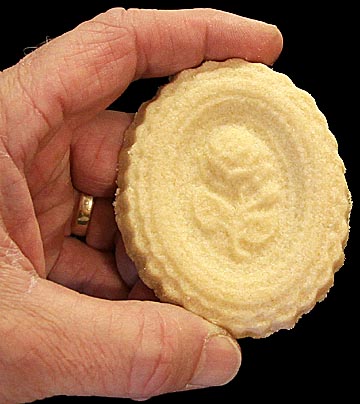
My favorite shape: a scalloped oval with a rose in the center.
Finally, is the simple satisfaction of making something from scratch.
So, having settled that question... let's get baking!
How
Much Flour?
While the earliest recipes for shortbread site a 1-2-3 ratio, that's based on oat flour, which is substantially different than wheat flout. I found oat flour produced an unpleasantly course texture and odd flavor. So for the purposes of this page we're limit ourselves to wheat flour. Researching over two dozen recipes disclosed that the ratio of sugar to flour (1-3 in early oat recipes) varied from 1-4 to as high as 1-7. To determine what was the best ratio I made five test batches with sugar to flour ratios of 1-3. 1-4, 1-5. 1-6 and 1-7. The image below shows how they compared after baking:

From left to right: 1-3, 1-4, 1-5, 1-6 and 1-7 parts sugar to flour.
The one part sugar, two parts butter and three parts all purpose flower cookie on the far left melted down into a greasy, paper thin mess that was closer to a tuile cookie than shortbread. The 1-4 ratio cookie had a very light and delicate texture that lacked the hearty body I think of for shortbread. It was also still a little greasy. The 1-5 cookie in the center was good, but still a little too light in texture and it also lacked the depth of flavor the best shortbread has. Both the 1-6 and 1-7 cookies were excellent. My preference was for the 1-7 on the far right. It had the solid texture of a true shortbread cookie with a deep, rich, full bodied flavor. It also held its shape the best, retaining the finest detail.
Although not pictured, recipes using more flour were attempted but they came out too rocky in texture. They were also almost impossible to mold into cookies that would hold their shape.
Having discovered that high-flour shortbread cookies turn out the best, I baked two more batches using cake flour and unbleached flour. Cake flour produces cookies with a more delicate initial crunch, but they quickly become unpleasantly gummy as they are chewed. Unbleached flour coarsens the texture and although the flavor is deepened, it moves away from the rich butteriness I associate with Scottish shortbread.
Next I dared to break with tradition by trying both regular and butter flavored Crisco. In both cases the cookies came out with a more delicate crunch but were grossly inferior in flavor.
I
also tried using powdered sugar in place of granulated sugar. The
result was cookies that were so rock hard they could be used for
hockey pucks.
Many recipes call for rice flour. I tried it and discovered that it gives the cookies a more delicate crunch, as does adding baking powder. The problem with both is that traditional Scottish Shortbread doesn't have a delicate crunch. It's not rock hard but it is solid with a good, honest chew. If you make the recipe that resulted from all the experiments on this page and decide it's too hard for you, replace some of the all purpose flour with an equal amount of rice flour. I suggest keeping the amount changed small because a lot of the cookie's flavor comes from flour. Using too much rice flour will weaken the taste.
I made one batch of shortbread with vanilla and discovered that it didn't change the flavor and gave the resulting cookie an unattractive gray color.
All
of the above indicated that the best recipe so far uses one part
granulated sugar, two parts butter and seven parts all purpose flour.
Unfortunately, I was soon to discover that this was only the beginning.
To
Dock or Not To Dock?
Every recipe I reviewed stated that it's necessary to dock, poke a lot of holes in, shortbread dough to relive the steam given off by butter as it bakes to prevent the cookie from puffing up. I've even seen this done on cooking shows... but I noticed that undocked areas didn't rise anymore that the docked areas. Since docking a pressed shortbread cookie is certain to damage the design, this was one step I had to confirm.
Each of the cookies shown in the flour ratio image had a twin that was undocked and baked next to it at the same time. In each and every case the undocked shortbread cookie failed to rise any higher than its docked brother.
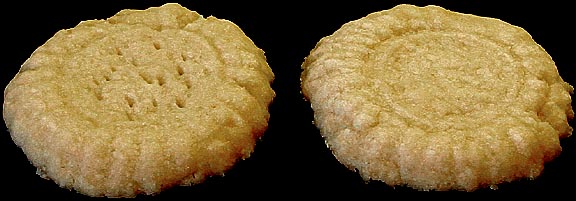
Docked shortbread on the left, undocked on the right.
I have no explanation why everyone insists that Scottish shortbread has to be docked when this test, which I've repeated numerous times, fails to show any effect. I suspect it's one of these traditions that's been repeated so many times that it's become dogma. Dock if you want, but for myself this is a step that can be avoided.
The
Question Of Salt:
Adding salt to anything makes it taste better, as long is so much isn't added that it makes whatever it's being added to taste salty... except potato chips where "saltiness" is the desired flavor. The reason is that small levels of sodium chloride (table salt) react with taste buds to make them more reactive to flavors. Properly salted meat doesn't taste salty but instead tastes more "meaty." The same effect takes place in sweet treats like shortbread. The problem is determining how much to add. I conducted several tests and found that it only takes 1/8 teaspoon of salt for a shortbread recipe based on 1/4-cup sugar, 1/2-cup butter and 7/4-cup all purpose flour. Then I discovered a problem.
One-eighth of a teaspoon is so little that even after vigorous mixing some dough had too little and some had too much. The answer was to use popcorn salt, which is much finer and able to spread itself more evenly through to mix.
Baking
Problems:
Once I got the following basic recipe:
1/4-cup
sugar
1/2-cup
room temperature salted butter
7/4-cup
all purpose flour
1/8-teaspoon
popcorn salt
I figured my problems were over. They weren't.
The next challenge was figuring out the best way to bake Scottish shortbread. While most recipes called for baking in a 350-degree F. oven for 18 minutes, a few others suggested baking longer times in 300 and even 250-degree ovens. As if that wasn't bad enough, how long the cookies have to bake at a given temperature is dependant on how thick they are made.
What followed was many experiments with various baking techniques. The result is a bit odd but produces the best and most consistent results.
The first baking problem was how to prevent the bottoms of the shortbread from burning before the top was baked. I tried using new, shiny cookie sheets, silicone baking sheets and two-layered airbake sheets. In the end the technique that produced the best results was to cover the cookie sheet with six layers of paper toweling on top of which I placed a sheet of non-stick aluminum foil. The paper insulates the bottom of the cookie so that they bake only very slightly faster than the tops.
As for baking times, I found that the first step was to decide what thickness and shape of cookie I wanted. I used the oval cookies shown at the top of this page. Each one is made from 1/4-cup of loose dough (more about that in the final recipe.) This creates an attractive cookie that's 1/2-inch thick. Having standardized as much as possible, I proceeded to bake several batches of cookies at various temperatures and times. I discovered for this particular shape of shortbread, the best result is obtained by baking at 300-degrees F. for 32 minutes. Any less and there isn't sufficient caramelization to create the desired deep, rich flavor and the texture is doughy. Any more and the shortbread becomes too hard. Thicker cookies have to bake longer at a lower temperature so the insides get done before the outsides burn.
Optimizing
The Amount Of Sugar:
Once the baking issues were resolved, it was necessary to revisit the ratio of ingredients to make sure subsequent tests hadn't changed things so much that the basic recipe needed doctoring. I discovered that as is, the shortbread had a good, rich flavor... but it was leaning a little too far into the savory realm of flavors. Increasing the sugar to 1/3-cup created a beautiful balance between sweetness and heartiness that was everything great shortbread should be.
If you prefer sweeter cookies, an alternative to increasing the sugar, which can affect texture, is sprinkling sugar over the tops of the cookies. It increases the sweetness and gives them a nice sparkle.
The
Final Recipe:
Here then is the final recipe that came out off all the tests:
Beat together 1/3-cup of white granulated sugar with 1/8-teaspoon of popcorn salt and 1/2-cup (1 stick) softened salted butter on high until light and fluffy.
Add 7/4-cup (1 and 3/4-cup or 215 grams) all purpose flour and mix until evenly blended.
The
result will be an extremely dry, fine meal that looks like it will
never hold together to make a cookie.
Scoop
1/4-cup of this meal into the cookie mold of your choice as long as
it's around 3-inches by 2-inches. You want the finished cookie to be
1/2-inch thick. Using your fingers, very firmly press the dough into
the mold, make sure the the edges are pressed down so they don't
break off when the cookie is released from the mold. If you are using
a flexible plastic mold, bend it slightly to loosen but not break the
dough and turn the cookie out onto the cookie sheet. If you're using
a hard mold, tap its edge on the counter all the way around to loosen
the cookie. I get 12 rose-oval cookies from this recipe.
Arrange the cookies on the cookie sheet covered with paper and foil as explained before and bake for 34 minutes at 300-degree F. The exact baking time will vary depending on the size and shape of your particular cookies. Ideally, the bottoms should have a light browning and the tops should be evenly tan or very pale brown. If you smell something like a deliciously roasty nuttiness check your cookies right away, they're probably done and may even be overdone.
Immediately move baked cookies to a cooling rack. Butter tends to migrate to the hottest part of the cookie. Leaving them on the hot cookie sheet could result in the bottoms becoming greasy.
Some references state that the flavor and texture of Scottish Shortbread improves after it's aged in an air tight container for several days or even weeks. I've tested this and haven't found any improvement.
Where
To Get Cookie Molds:
The best Scottish shortbread cookie molds I've found are plastic molds used for soap making. These are available in most craft stores and only cost a few dollars for a sheet of six molds.
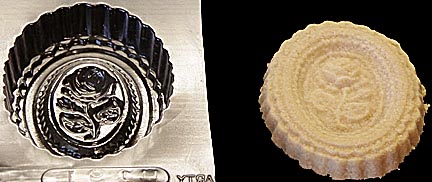
Another option is to use epoxy putty to create your own.
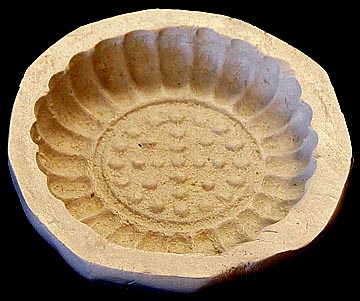
The
image above is not to scale relative to the first mold.
This
one is actually half the size of the oval mold.
I made the one above by brushing a Walkers shortbread cookie with Crisco then pressing epoxy putty over it. Any object can be used and objects even combined to make whatever design you desire. Of course you only want to use a food grade epoxy.
Conclusion:
Scottish shortbread is one of the simplest and most satisfying of all cookies. Although its flavor is more subtle than most cookies, good shortbread has an optimum balance between deep buttery flavor and sweetness that elevates it to one the the great gastronomic delights. I hope you've found this page interesting and that you enjoy my recipe.
IMPORTANT UPDATE!!!
Several months after creating this page I happened to try the large shortbread cookies sold by the Panera Bread restaurant chain in Southern California. I have to admit that they are simply the best I've ever tasted. My ego hates to admit it but they are far better than the recipe developed for this page. They're a little sweeter than mine but not so much so that their rich buttery notes are overpowered. While their flavor is outstanding, the best thing is that they have a light, airy, melt-in-your-mouth texture that is a delight to experience. At first I thought this was achieved by adding baking powder to the recipe, which would have made them short cake rather than short bread. However, upon reading the ingredients I discovered they contain only classic short bread ingredients. I suspect they include more water than mine, which turns to steam and in so doing puffs the cookies up and lightens them. If you have the opportunity to try one of these wonderful cookies I heartily encourage you to do so. If you love great short bread you won't be disappointed. (Please note: I don't own stock in Panera Bread and they didn't pay or ask for this endorsement.)
NEW NUMBER ONE BEST TASTING SHORTBREAD COOKIE!!!
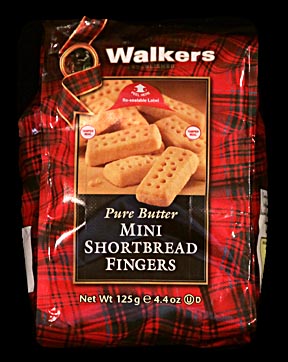
Early in 2013 I noticed that the Panera cookies began tasting overly sweet, as if the recipe had been changed. At the same time Walkers released a new mini form of their standard shortbread cookies. In my opinion the Walkers minis are now the best tasting shortbread cookie available. They are richly flavored, have a perfectly balanced sweetness and leave a deeply satisfying flavor on the palate. They are better than the much large standard Walkers cookies. I believe the reason is that much of the flavor comes from the caramelization of the outside during baking. These mini cookies have a much higher ratio of surface area to volume than the standard cookies so they have more flavor. At 1-inch long, they are a perfect one-bite size. As of April, 2013, I've only been able to find these excellent cookies in CVS pharmacies. This limited release suggests they may be a test marketing. I sincerely hope everyone reading this page buys all they can find not only to stock up on some of the best shortbread they'll ever find, but also to send a message to Walkers that there is a demand for this outstanding cookie.
Update!!! By June of 2014 I found these excellent cookies were available in half the supermarkets in my town, suggesting that they are a success. In an even better development Walkers has released a smaller round mini shortbread cookie that's even better than the original mini rectangular cookie. That's the good news. The bad news is that I've noticed some variation in quality. Rectangular cookies with the Nov 2014 code are terrible. They taste doughy, as if they hadn't been baked long enough. Those with the Sep 2014 code were excellent. Hopefully this bad run was a one time error. I wrote Walkers about this but they didn't even offer me the courtesy of an automated acknowledgement.
If
you enjoyed this page, you may like to browse my main site THIS
AND THAT. There you'll find over 100 non-commercial
pages dealing with everything from knitting Nancies to the strange
world of lucid dreaming. If nothing else the 30 pages of jokes should
be good for a laugh.
Recipes I reviewed For This Page:
SCOTTISH
SHORTBREAD COOKIES
Ingredients
· 1 pound unsalted butter
· 5 cups all-purpose flour
· 1 cup white sugar
Directions
1. Preheat oven to 350 degrees F (180 degrees C).
2. Cream butter and sugar with mixer. Add flour and mix with a wooden spoon. Use hands to thoroughly mix.
3. Press into a jelly roll pan. Prick to bottom all over with a fork being sure the fork hits the bottom and the pricks are close together.
4. Bake for 10 minutes. Reduce the heat to 300 and continue to bake for 40 minutes more. Wait 2 minutes then cut into finger size bars. Cool thoroughly in pan
SCOTTISH SHORTBREAD COOKIES
Ingredients
· 1 1/2 cups all-purpose flour
· 1/3 cup white sugar
· 3/4 cup butter
Directions
9. Preheat oven to 350 degrees F (180 degrees C).
10. Blend all ingredients well. Dough will be stiff.
11. Press into a 9 x 9 inch buttered dish. Prick top with a fork.
12. Bake until pale golden brown on the edges. Cool and cut into squares.
SCOTTISH SHORTBREAD
1 cup unsalted butter
3/4 cup confectioner's sugar
1/2 teaspoon vanilla or almond extract
2 1/4 cups all purpose or pastry flour
1/4 cup rice flour
1/4 teaspoon salt
Beat butter until soft. Add sugar and extract. Beat until smooth. Stir salt into flour and mix well, then add flour and salt mixture to first mixture.
Press dough evenly into a round cake pan. Score into wedges (or petticoat tails) with a fork. Do not cut straight through the dough - score only 3/4 way through. Decorate lightly with patterns and frills if desired.
Bake in 375-degree oven 25 minutes. Cut along markings while still hot. Cool in pan, then turn out and sprinkle with a light dusting of confectioner's sugar if serving right away, or store in an airtight tin
SCOTTISH SHORTBREAD
1 c butter, softened
1 2/3 c flour, all purpose
1/3 c rice flour
1/4 c sugar, granulated
1/4 c brown sugar, packed
Grease 8" round cake pan. Line bottom with wax or parchment paper.
Cream butter until fluffy, but not too much. Mix in both types of sugar, then both flours with electric beater until dough is crumbly and clumps together when pressed. Spread evenly in prepared pan and pat down lightly.
Bake in preheated 352F oven 45 minutes.
Remove from oven, and with sharp knife or fork, score into 12 wedges, cutting about 3/4 way through dough. Score with a fork in decorative patterns.
Return to oven; bake about 15 minutes longer or until just lightly golden at edges.
Cool in pan on rack 30 minutes. Loosen sides. Turn out and invert.
Cool completely.
SCOTTISH SHORTBREAD
1 cup butter, softened
1 egg yolk
1 tablespoon vanilla extract
3/4 cup confectioner's sugar
2 1/2 cups all-purpose flour, unsifted
1/4 cup cocoa powder
1/4 teaspoon salt
1/4 teaspoon ground cinnamon
In mixer bowl, cream butter for 2 minutes. Beat in egg yolk and vanilla. Gradually add sugar and continue beating until smooth.
Combine flour, cocoa, salt and cinnamon. Gradually blend flour mixture into butter mixture with hands or wooden spoon.
Knead mixture on a smooth, flat, unfloured surface (such as a countertop) for 2 to 3 minutes, scraping with metal spatula. Dough will be sticky but pliable.
Spray shortbread mold with vegetable shortening. Press dough into mold.
Bake at 325 degrees for about 45 minutes or until cake is slightly springy to the touch. Cool in mold on rack.
When cool, loosen around edges with
SCOTTISH SHORTBREAD
Ingredients
· 1 pound unsalted butter
· 5 cups all-purpose flour
· 1 cup white sugar
Directions
5. Preheat oven to 350 degrees F (180 degrees C).
6. Cream butter and sugar with mixer. Add flour and mix with a wooden spoon. Use hands to thoroughly mix.
7. Press into a jelly roll pan. Prick to bottom all over with a fork being sure the fork hits the bottom and the pricks are close together.
8. Bake for 10 minutes. Reduce the heat to 300 and continue to bake for 40 minutes more. Wait 2 minutes then cut into finger size bars. Cool thoroughly in pan
SCOTTISH SHORTBREAD COOKIES
1 cup softened butter
1/4 cup light brown sugar
1/3 cup powdered sugar
2 cups flour
9 inch cake pan
Cream the butter (electric mixer). Add the sugar, but keep creaming. Then slowly add the flour. Press the dough down into the pan. Then bake at 325 for 40 minutes or until golden brown. Let cool in pan. Enjoy!
SCOTTISH SHORTBREAD (COOKIES)
1 c. butter
1/2 c. powdered sugar
2 c. flour
1/4 tsp. baking powder
1/4 tsp. salt
Cream butter, gradually add sugar. Blend dry ingredients. Roll out 1/4 inch thickness on floured surface. Cut with 2 inch cutter. Place on ungreased sheet and decorate with cherry or citron (optional). Bake at 350 degrees for 12 minutes. Yield 4 dozen.
SCOTTISH SHORTBREAD COOKIES
1 lb. butter
4 c. flour
2 tsp. vanilla
Dash of salt
3/4 c. sugar
Combine all ingredients well. Form into rolls approximately 1 1/2 inches in diameter. Roll in sugar (may be colored). Refrigerate well. Slice into 1/4 inch slices, place on ungreased baking sheet. Bake at 350 degrees for 8 minutes.
MELT-IN-YOUR MOUTH SCOTTISH SHORTBREAD
COOKIES
Read more about it at www.cooks.com/rec/view/0,1610,158175-230204,00.html
Content Copyright © 2011 Cooks.com - All rights reserved.
1 1/4 c. powdered sugar
4 c. flour (bleached flour works best)
2 tbsp. cornstarch
4 cubes butter (no substitutions, please) room temperature
Stir together powdered sugar, flour and cornstarch. Cut in butter until dough is consistency of play dough. Divide dough into 4 equal parts. Form into balls. With rolling pin on very lightly floured surface, shape each ball into a 1/4 inch thick round. Transfer to baking sheets (two cookies per sheet). Prick each cookie with a fork in a pretty design. Bake at 275 degrees for 25 to 30 minutes.
When cooled, break apart into pie wedge sections.
Note: 1 cube of butter equals 1/2 cup or 8 tablespoons butter (one stick).
SCOTTISH SHORTBREAD
1 lb. real butter (no substitute)
1/4 c. Crisco
3/4 c. sugar
6 c. flour
Let butter come to room temperature. Mix butter, Crisco and sugar by hand until soft and creamy. Add flour slowly gradually working all into a ball (use your hands). Separate into 5 or 6 balls. Shape on wax paper to fit pans making it 1/2 inch thick. Score top with fork to make it easier to cut later. Bake at 325 degrees for 10 minutes.
Rotate pans in oven and bake 10 minutes longer. Remove from oven and cut again on lines so you can remove it when desired. Make shortbread in pans you can give to your neighbors on holidays.
SCOTTISH SHORTBREAD
1 lb. butter
1 c. sugar
4 c. flour (do not sift)
Cream butter. Add sugar, 1/2 at a time, until smooth. Work in flour gradually, best done with your hands. Roll dough 1/4 inch thick, then cut dough into 1 inch by 2 inch rectangles. Prick each rectangle with fork several times. Bake on ungreased cookie sheet for approximately 45 to 50 minutes at 275 degrees.
SCOTTISH SHORTBREAD
1 c. sugar
2 c. butter (room temp.)
5-6 c. sifted flour
Put flour on counter first and add butter and sugar. Knead until comes off counter clean. Put on cookie sheet with small lip. Roll with rolling pin flute with knife on edge. Prick with fork all over. Bake 10 minutes at 375 degrees then 30 minutes at 350 degrees. Electric oven may be hotter. If browning to fast cover with foil or brown bag. Cut while hot and cool in pan.
SCOTTISH SHORTBREAD
1 c. butter, room temperature
1 c. and 2 tbsp. powdered sugar
1 1/2 c. and 2 tbsp. flour
1 scant cup cornstarch
White sugar
By hand, mix the softened butter and powdered sugar until thoroughly mixed. Add the flour and cornstarch and knead in bowl into a smooth dough. Press the dough into 2 round 8 inch pie pans. Lightly prick surface with fork and bake at 350 degrees for 30 minutes until it is a pale golden.
Remove from oven and cut into wedges while still hot. Sprinkle with white sugar. Cool before you remove. Freeze well. Store in tightly covered container.
SCOTTISH SHORTBREAD
1 c. butter, softened
1/2 c. sugar
2 1/2 c. flour
2 inch cookie cutter
Cream butter and sugar until light and fluffy (approximately 5 minutes). Stir in flour. Dough will be crumbly. Knead dough together until forms a ball.
Roll out on lightly floured surface approximately 1/4 inch thick. Cut out with cookie cutters. Place on cookie sheet. Prick with fork a couple of times. Bake at 300 degrees for 30 minutes.
SCOTTISH SHORTBREAD
1 lb. butter (do NOT substitute butter)
1 c. sugar
5 c. flour
Cream together butter and sugar. Add flour slowly. Roll out dough 1/4" to 1/2" thick. Cut into squares. Prick with fork. Place on ungreased cookie sheet. Bake at 350 degrees for 20 to 25 minutes until golden. These cookies will keep for long periods of time if left in a tightly sealed container.
MACKINTOSH SCOTTISH SHORTBREAD
1 stick butter (1/2 c.)
1/4 c. superfine sugar (MAY substitute with powdered sugar)
1 c. flour
Let butter soften slightly at room temperature. Mix butter and sugar together. Add flour and mix with a fork, thoroughly, so CRUMBLY in texture. "Pack" lightly in 8 inch pie plate. Bake at 325 degrees for 45 to 50 minutes, until golden brown. Cut into pieces. Allow to cool.
SCOTTISH SHORTBREAD
1 c. softened butter
1/2 c. sugar
4 c. plain flour
Place butter, flour and sugar together in a bowl. Using one hand, squeeze the ingredients together until a ball of dough forms. Alternatively, place butter and sugar in the bowl of a mixer and mix together but do not mix to a cream. Add flour at a slow speed until a dough forms that can be handled. Divide the ball into three and press each third into a 7 inch baking tin and bake in the center of a preheated 325 degree oven for 25 to 30 minutes or until lightly browned. While warm, sprinkle sugar over and cut into 8 pieces (makes 3 rounds, 24 pieces).
SCOTTISH SHORTBREAD COOKIES
1 c. (1/2 lb.) softened butter
1/2 c. sugar
2 1/2 c. sifted all-purpose flour
Beat together butter and sugar in large bowl until smooth. Gradually work in flour with wooden spoon to make stiff dough. Shape into ball, flatten. Wrap in wax paper. Refrigerate 30 minutes.
Roll dough into out 1/2 inch thickness. Cut into 3 inch rounds. With wide spatula place cookies 1 inch apart on cookie sheet. Bake in preheated 300 degree oven for 30 minutes or until until pale golden. Remove to wire rack, cool completely. Store in tightly covered container.
SCOTTISH SHORTBREAD
1 c. sugar
1/2 lb. butter (2 sticks)
1/2 lb. butter (2 sticks)
4 c. flour, presifted
Additional sugar
1/2 tsp. vanilla
In large bowl cream 1 cup sugar, butter, butter. Blend in flour, one cup at a time. Add vanilla. Put into ungreased jelly roll pan. Prick with fork all over entire surface. Bake at 250 degrees for 20 minutes. Increase to 350 degrees. Bake 10 minutes more or until lightly brownish. Cut into squares while still hot. Cool in pan after cutting. I use a broiler, 11 1/2 x 16 inch pan.
SCOTTISH SHORTBREAD COOKIES
3 c. plain flour
1/3 c. Semolina or Ground Rice (from Heath Food Store)
1 c. butter
1/2 c. sugar
Process all ingredients in food processor until dough forms one piece. Roll out on floured board or between waxed paper until 3/4 inch thick. Cut into fingers. Place on greased baking trays and mark tops of fingers with a fork. Bake at 350 degrees for 20 to 25 minutes, until a pale golden color. Cool fingers on wire rack
SCOTTISH SHORTBREAD
1 1/4 c. all-purpose flour
3 tbsp. cornstarch
1/4 c. sugar
1/2 c. (1/4 lb.) firm butter, cut into pieces
1 tbsp. sugar
Mix together flour, cornstarch and sugar. Rub in the butter with fingertips until crumbly and no large pieces remain. Gather mixture together into a ball, place in an ungreased 8 or 9 inch round baking pan. Press out firmly into an even layer. Make impressions with the fork around the edge and prick the surface evenly.
SCOTTISH SHORTBREAD COOKIE
1 c. butter (the real thing)
2 c. flour, sifted
3 tbsp. powdered sugar
3 tbsp. rice flour
Beat butter until creamy, add flour and work in well. Add mixed sugar and rice flour. Work in and knead for several minutes (an important step). Roll or pat out to 1/2 inch thickness (use a little flour if needed to prevent sticking). Cut to shape with floured cutter. Bake at 275 degrees for 50-60 minutes or until faintly brown.
SCOTTISH SHORTBREAD
1/2 lb. butter
1/2 c. very fine sugar
2 c. flour
Have butter at room temperature and cream well. Gradually cream in sugar. Work in flour to cookie consistency. Roll on lightly floured board. Cut in desired shapes. Pierce each cookie through twice with a fork. Decorate if you wish or leave plain. Bake on ungreased cookie sheet until golden brown at 350 degrees 10 to 12 minutes. They brown quickly because of the amount of butter.
SCOTTISH SHORTBREAD
1 lb. sweet butter
3 1/2 c. sifted flour
1 1/2 c. sugar
1 c. white rice flour
Cream butter and sugar. Sift flour and rice flour and fold into butter and sugar mixture, one cup at a time. Work dough with hands for 10 minutes. Pat into a 11x16 inch cookie sheet with palm of hands. Sprinkle very lightly with sugar and cut into bars with a fork. Bake in a 300 degree oven for 55 minutes. Cut again to cool.